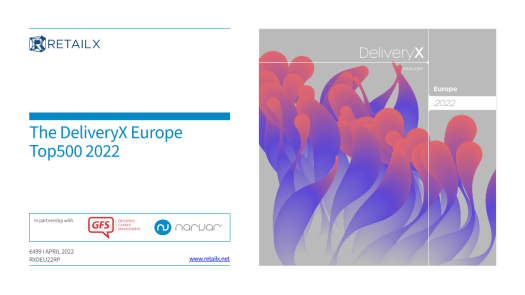Sub-heading and brief description. Lorem ipsum dolor sit amet, consectetur adipiscing elit. Ut elit tellus, luctus nec ullamcorper mattis, pulvinar dapibus leo.



The DeliveryX Europe Top500 report delves into the Operations & Logistics dimension, looking closely at the performance and capabilities of the Top500 retailers. Our researchers rank the businesses based on their performance across all of the RetailX Performance Dimensions, with a focus on those within the EU, EEA, Switzerland and the UK.
Our researchers examine how services across the retail industry are changing, as well as the trends being followed by this retail cohort. Capabilities altering across regions or retailers of similar product categories are also highlighted, along with the resulting service expectations of consumers buying from those retailers. It answers questions including the countries in which reserve & collect is expected and the product segments most likely to offer free returns.
Are consumers willing to pay extra for faster or more eco-friendly deliveries? Does a bad returns experience deter customers from shopping with retailers again? How many of the Top500 offer collection? Does carrier choice impact sales?
Download the full report to discover all this and more.
 Welcome to the DeliveryX Europe Top500 report. This report is a special investigation into the Operations & Logistics capabilities of the Top500 retailers across Europe and a ranking of the leaders.
Welcome to the DeliveryX Europe Top500 report. This report is a special investigation into the Operations & Logistics capabilities of the Top500 retailers across Europe and a ranking of the leaders.
RetailX has been measuring, assessing and analysing the behaviour, services and promises of Europe’s retailers since 2016. This enables an understanding not simply of who the leading retailers are but, more importantly, what makes each a leader.
To join the ranking takes more than being outstanding in one business area alone. Having the largest store estate in a single country or the highest performing mobile app doesn’t automatically translate to inclusion. It requires a retailer to be at the top of their game in all of the RetailX Performance Dimensions, across the 32 countries assessed by the research team. These comprise the EU, EEA, Switzerland and the UK.
Looking at what the team has done in investigating these retailers by the measures contained in the Operations
& Logistics Dimension – and therefore each retailer’s capabilities in these areas – highlights the importance
Introduction of these capabilities. The services offered by retailers, the ensuing customer experience and the competitive advantages they bring.
Analysis over time also brings to light the larger picture. It gives an image of how services across the retail industry are changing, as well as the trends being followed by this retail cohort. Capabilities altering across regions or retailers of similar product categories are also highlighted, along with the resulting service expectations of consumers buying from those retailers. It answers questions including the countries in which reserve & collect is expected and the product segments most likely to offer free returns.
This latest analysis was carried out in March 2022 and many of the figures in this report compare today’s viewpoint against February 2020. In this way, fluctuations caused by the pandemic are eliminated and trends that are more longer-term are extrapolated.
The thoughts of consumers are also included in response to questions such as whether they are willing to pay extra for faster or more sustainable delivery, how many have stopped shopping with a retailer due to a bad returns experience and whether carrier choice impacts sales.
I’ll finish by congratulating all of the retailers that have made it into the Top500 ranking – an achievement that
pertains to their hard work and the effort of teams across their retail operations and, in particular, to those involved in Operations & Logistics.
Ian Jindal, CEO, RetailX
DeliveryX top retailers exemplify the Operations & Logistics Dimension rating through delivery, collection and returns.
The first RetailX EU retailer (RXEU Top500) ranking was published in 2016. Since then, the research team has been developing, refining and adjusting how retailers across Europe are measured in correlation to how the industry develops. Through all these tweaks and additional measures, the major themes – and Dimensions – upon which all retailers are assessed have remained the same:
First, each retailer’s footprint is recorded. This covers European retail turnover, ecommerce turnover, web reach
and store estate of retail businesses to give the ‘heft’ and a preliminary rank. (For an explanation of what constitutes a retailer, or those that it excludes, see page 25.) We then modify and weight that analysis through consideration of the following Dimensions:
These Performance Dimensions provide not only a way to benchmark retailers but also form a picture of the current state of an ever-changing industry and the promises made by retailers to customers. Measurements and assessments over the years show the trends in consumer and retailer behaviour and how they are developing from one year to the next. They also shine a light on emerging innovations that will become long-lasting changes for all.
The Operations & Logistics Dimension consists of multiple metrics assessing behaviour and retailer promises in order to discover what promises Top500 retailers make on delivery, on returns and on collection, and what multichannel services these retailers offer. These metrics are split as follows:
What is apparent since retailers were assessed for the first time is the important part that logistics and operations now play in a retailer’s position, as well as in the success of their overall business. Efficiencies are being made to reduce costs, with many of these same efficiencies also improving business processes and enabling new or more appropriate services to be offered to customers. Aligning services to customer demand, or to bring what’s offered into alignment with market expectations, usually results in a better experience for customers.
Done in the right way, logistics operations can offer competitive advantage, be that by delivering faster than retailer rivals, cheaper than them, or providing shoppers a later cut-off for orders. In some cases, innovation is the answer, resulting in a retailer being the first to develop a solution to a customer issue, or one they hadn’t even realised was a problem until a better solution was offered. When the first grocery orders were placed online, was it anticipated that consumers would one day want to order multiple bags of shopping for delivery in just ten minutes?
What the consumer sees – the final mile experience, or the benefit of shopping with retailer Y rather than X – is only part of the story, one that is backed by the full operational workings of warehouse, supply, logistics and so on.
Expanding on the ideals of Service, Experience and Advantage, this DeliveryX Europe Top500 report represents a new way to look at the RXEU Top500. It showcases where retailers are bringing delivery logistics to a point of excellence while also highlighting the extent to which the industry has moved away from pre-pandemic delivery promises as Covid-19 stretched delivery capacity while putting restrictions in the place of bricks-and-mortar retailing.
The following pages will show how behaviour has altered as customer expectations changed. We also highlight the current trends that could be next year’s ‘normal’ for this important part of the retail chain.
Although delivery remains the preferred fulfilment method, the pandemic has seen retailers dropping next-day service.
Since February 2020, change in the retail industry has undergone unprecedented acceleration, with the pandemic shaking up all areas of our lives, including how, when and where we shop. The experience in different countries across Europe differed, with some seeing bricksand-mortar stores in certain product categories temporary closed. Other remained open throughout.
One thing that was the same across the continent was consumers switching more of their shopping online. This increasing volume of orders tested retailer operations to the limits, putting pressure on warehouse operations already stressed by social distancing of staff. Yet how retailers and the industry managed ecommerce delivery during the pandemic is exemplary and the lessons learned in agility, flexibility and scale are ones that everyone will take forward. One of these is the need for faster processes to support growing ecommerce activities.
European supermarket giant Carrefour is going down the route of voice picking at its newly opened distribution centre in Belgium. The solution will help it to fulfil 5,000 orders each day, while allowing employees to work completely handsfree, which greatly optimises their mobility.
Fashion retailers, which saw sales fall in 2020 due to customers remaining at home, are now reporting increased sales and a need for more warehouse space. H&M is expanding the capabilities of its warehouse in Stryków, Poland from which orders are picked, packed and despatched to customers in Czechia, Hungary, Bulgaria and Slovakia.
Consumers are not expected to return to pre-pandemic buying behaviour and much of the online purchasing will continue, albeit with revised consumer expectations. Choice of how and when an online order is delivered or collected is still a vital part of the ecommerce experience – as is the cost to the consumer – and these expectations vary between countries. Delivery is still preferred over collection, with most customers expecting to wait for three to five days for their online order to arrive. What has changed are the nuances of those services.
The number of retailers offering next-day delivery has decreased by 8 percentage points since February 2020. Just 38% of the EU Top500 retailers measured by RetailX in both February 2020 and March 2022 now offer it. Services such as nominated-day and nominated-time delivery remain constant but are still only offered by a select few.